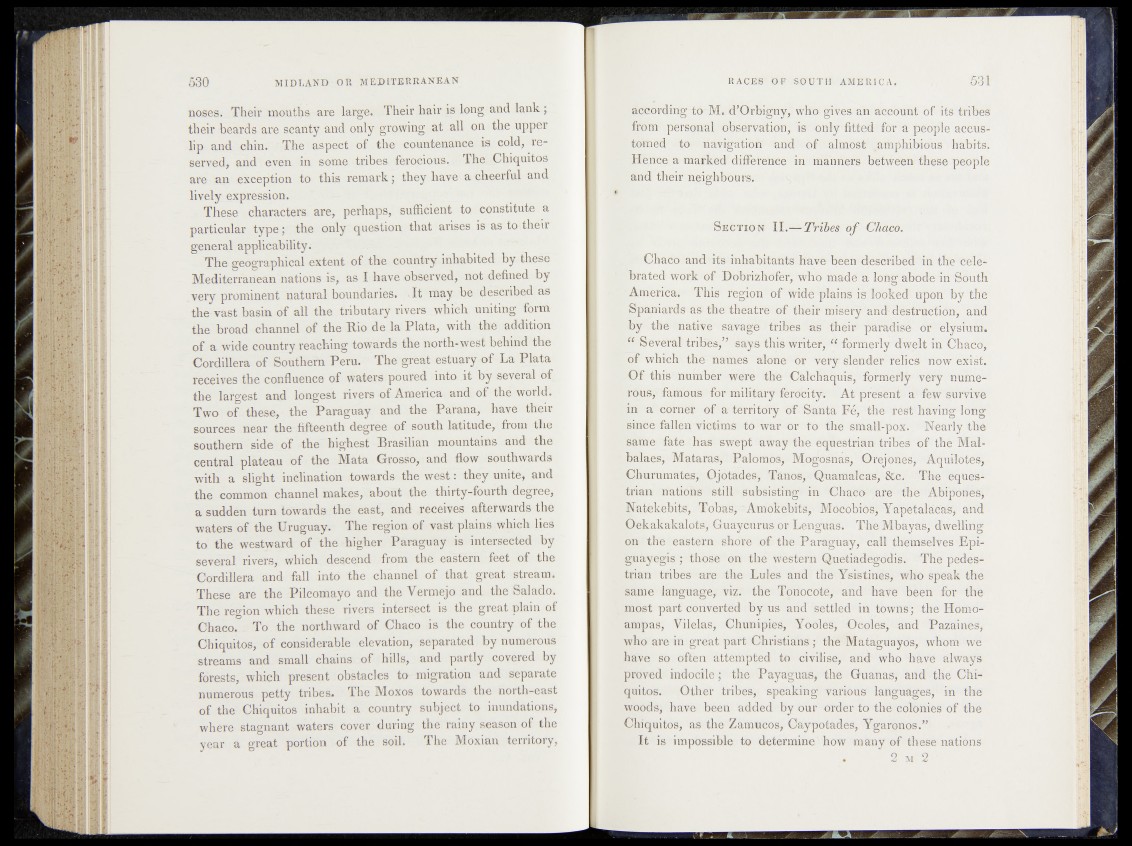
noses. Their mouths are large. Their hair is long and lank ;
their beards are scanty and only growing at all on the upper
lip and chin. The aspect of the countenance is cold, .reserved,
and even in some tribes ferocious. The Chiquitos
are an exception to this remark; they have a cheerful and
lively expression.
These characters are, perhaps, sufficient to constitute a
particular type; the only question that arises is as to their
general applicability.
The geographical extent of the country inhabited by these
Mediterranean nations is, as I have observed, not defined by
very prominent natural boundaries. -It may be described as
the vast basin of all the tributary rivers which uniting form
the broad channel of the Rio de la Plata,, with tfee addition
of a wide country reaching towards the north-west behind the
Cordillera of Southern Peru. The great estuary bf La Plata
receives the confluence of waters poured into i t by several of
the largest and longest rivers of America and of the world.
Two of these, the Paraguay and the Parana, have their
sources near the fifteenth degree of south latitude, from the
southern side of the highest Brasilian mountains and the
central plateau of the Mata Grosso, and flow southwards
with a slight inclination towards the west: they unite, and
the common channel makes, about the thirty-fourth degree,
a sudden turn towards the east, and receives afterwards the
waters of the Uruguay. The region of vabfc plains which lie9
to the westward of the higher Paraguay is intersected by
several rivers, which descend from the eastern feet of the
Cordillera and fall into the channel of that great stream.
These are the Pilcomayo and the Yermejo and the Salado.
The region which these rivers intersect is the great plain of
Chaco. To the northward of Chaco is the country of the
Chiquitos, of considerable elevation, separated by numerous
streams and small chains of hills, and partly covered by
forests, which present obstacles to migration and separate
numerous petty tribes* The Moxos towards the north-east
of the Chiquitos inhabit a country subject to inundations,
where stagnant waters cover during the rainy season of the
year a great portion of the soil. The Moxian territory,
according~to M. d’Orbigny, who gives an account of its tribes
from personal observation, is only' fitted for a people accustomed
to navigation and of almost1 ^amphibious habits.
Bence a marked diifeietBie in manners betweenthese people
and their neighbours.
S e c t io n I I . — Tribes o f Chaco.
Chaco and its inhabitants have been described in the celebrated
work of Dobrizhdfer, who made a loffig’abodoffn'^outh
America. This^’ifegioh of wMe'-plains is.(T^5bl§ed^ upoh^ljy'lfee
Spaniards as the theatre of their misery* and; destruction, and
by the native savageT? tribes as their paradise-bf elysfonk
p^Several tribes,” says this writer, “ formerly dwelt in Chaco'1,'
or which the names alone or very* Sflnder rehci^Hro^" exist.
-Of this number were the Calchaqui$,1fetaerly vei^ numerous,'
famous for military ferocity. "-At presfentv a*-few survive
in a'corner of a territory of Santa Fe, 'the^rest-having lbng
since fallen victims to war or to the small-poX.'PIP^rly the
same fate has swept away the equestrian tribes of the Mai-
balaes, Mataras, Palomos, Mogosnas, Orejones, Aquilofes^
Churumateg, Ojotades, Tanos, Quamale&S^&C; The Equestrian
nations still subsisting in Chaco are the Abipones,
Matekebits, Tobas, Amokebits, Mocobios, Yapetalaeas, and
Oekakakalots, Guaycurus or Lenguas. The Mbayas, dwelling
on the eastern shore of the Paraguay, call themselves Epi-
guayegis ; those on the western Quetiadegodis. The pedestrian
tribes are the Lules and the Ysistines, who speak the
same language, viz. the Tonocote, and have been for the
most part converted by US- and 'settled in towns'; the Ilomcb
ampas, Vilelas, Chunipies, Yooles, Ocble"S, and Pazaines,
who are in great part Christians; the* Matagbayds, whom wM '
have so often attempted to civilise, and who have always
proved indocile; the Payaguas, the Guanas, and the Chiquitos.
Other tribes, speaking various languages, in the
woods, have been added By our order to the colonies of the
Chiquitos, as the Zamucos, Caypotades, Ygaronos.”
It is impossible to determine how many of these nations 11 ill H11
m H h W -